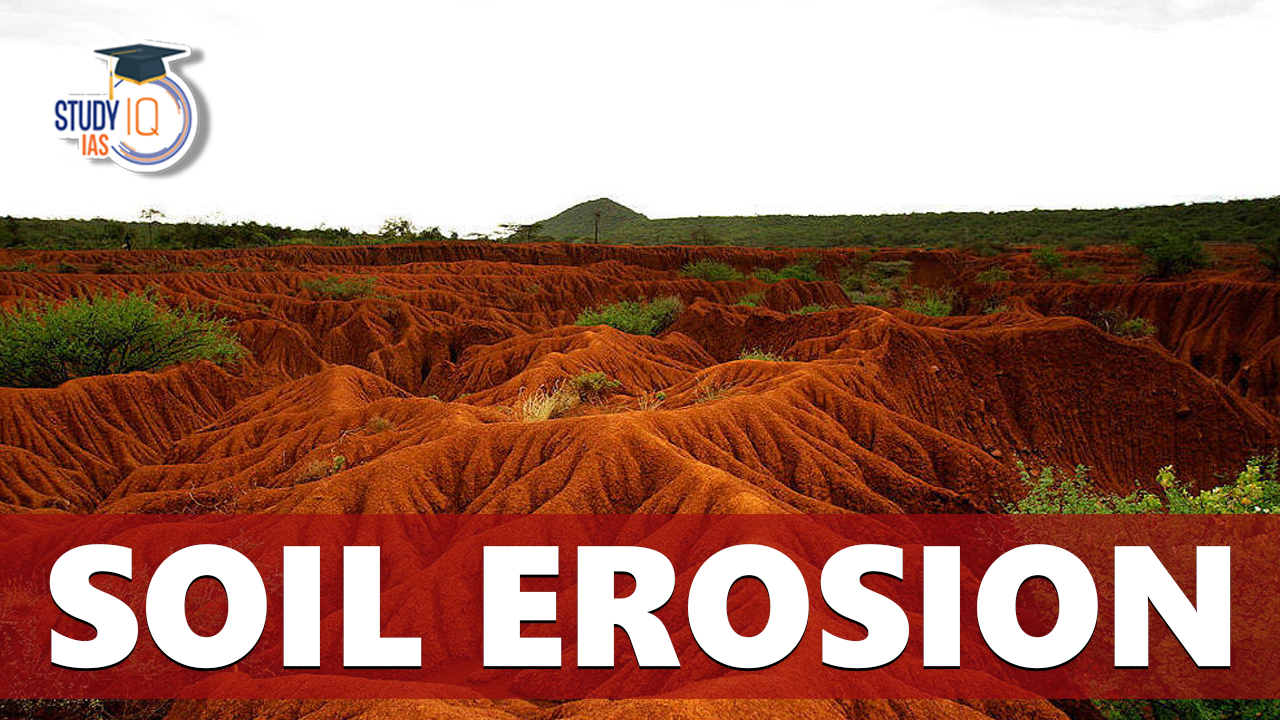Table of Contents
Soil is important for growing food for both people and animals. It provides plants with nutrients and support. Soil consists of organic material, minerals, and weathered rocks. Its formation depends on factors like rock type, climate, land shape, organic matter, and time, which vary by location. Human activities like deforestation, overgrazing, excessive chemical use, and natural events like heavy rain can harm soil, leading to soil erosion.
What is Soil Erosion?
Soil erosion is the natural process where soil and rocks are worn away by forces like wind and water. It happens everywhere and can not be stopped. Human activities like cutting down trees and floods make this process faster. Soil erosion can be slow (natural) or fast (caused by humans).
Cause of Soil Erosion
The causes of soil erosion are as follows:
Rainfall and Flooding
Soil erosion is primarily caused by rainstorms that are more intense. Rainfall results in four different types of soil erosion:
- Wind erosion
- Gully erosion
- Sheet erosion
- Splash erosion
The soil is dispersed by the showers and subsequently washes into the neighboring rivers and streams. Heavy soil loss occurs in areas with frequent and intense rains. By forming potholes, rock-cut basins, and other features, the flowing water during floods also erodes a lot of soil.
Agriculture
Soil erosion mainly happens because of farming activities. When farmers plant new seeds, they cut down trees and till the soil. Most crops are grown in the spring, so the land is left empty in the winter, causing a lot of soil to wash away. Tractor tires create grooves that act like natural waterways, and the wind blows away small soil particles.
Grazing
Grazing animals eat the grass and clear away plants from the land. Their hooves disturb the soil and can pull out plants by the roots. This makes the soil weaker and more likely to erode.
Logging and Mining
To carry out the logging procedure, several trees are felled. The soil is tightly held by trees. The soil is shielded from heavy rainfall by the forest cover. During logging, the leaf litter that shields the soil from erosion is also destroyed.
Construction
The soil is at risk of erosion due to the construction of buildings and roadways. For construction purposes, the forests and meadows are destroyed, exposing the soil and making it susceptible to erosion.
Rivers and Streams
Erosion activity takes the form of a V as a result of soil particles being carried away by rivers and streams in motion.
Heavy Winds
The tiny soil particles are swept away by the wind to distant countries during dry weather or in semi-arid zones. Desertification is the result of this soil degradation.
Effects of Soil Erosion
The major effects of soil erosion are mentioned below:
Loss of Arable Land
The top, fertile layer of the soil is removed by soil erosion. The important nutrients that the soil and plants need are abundant in this stratum. Low crop productivity results from the damaged soil’s inability to support crop production.
Clogging of Waterways
Pesticides, insecticides, fertilizers, and other chemicals can be found in agricultural soil. The waterways where the soil flows are contaminated as a result. Flooding is caused by the sediments that build up in the water and raise the water levels.
Air Pollution
Air pollution is caused by the dust particles combining in the atmosphere. When inhaled, some toxic compounds, like petroleum and insecticides, can be quite dangerous. When the winds blow, the dust plumes from the dry and semi-arid regions contaminate large areas.
Desertification
One of the main causes of desertification is soil erosion. Deserts are created where there were once inhabited areas. The situation is made worse by deforestation and disruptive land use. This results in a decrease in biodiversity, deterioration of the soil, and ecosystem changes.
Destruction of Infrastructure
The efficiency of dams and their banks may be decreased by the buildup of soil sediments. As a result, it has an impact on infrastructure initiatives like drainage, embankments, and dams.
Types of Soil Erosion
Based on the physical agent causing erosion, soil erosion is categorized in
- Water Erosion
- Wind Erosion
Water Erosion
Running water is one of the main ways that soil gets washed away. Rain, waves, and ice can all lead to soil erosion. The speed and way the water moves can create different types of erosion, and that’s why we have various names for it.
Wind Erosion
Where plants have been removed, wind can cause more soil erosion. This happens near sandy areas around lakes, rivers, and in dry places.
Soil Erosion Prevention
Some strategies for preventing soil erosion include the ones listed below:
- Plant trees: Trees help hold the soil together with their roots, preventing erosion on bare ground.
- Add mulch and rocks: Mulch and rocks protect the soil and plants underneath from eroding.
- Use mulch matting on slopes: Mulch matting helps stabilize the soil on slopes and prevents erosion.
- Place fiber logs: Fiber logs can stop soil and water from washing away.
- Build a wall at the bottom of slopes: A wall can keep the soil from eroding by providing a barrier at the slope’s base.
Conservation of Soil Erosion
The conservation of soil erosion is essential check some of the important conservation measures below:
- Because the roots of plants hold soil particles together, it is crucial to maintain vegetation cover so that soil is not exposed to rain. Plants deflect rain and shield the ground from its direct effects.
- Controlled cattle grazing is necessary.
- The use of crop rotation and fallow land (area that hasn’t had anything planted in it for a while) should be encouraged.
- To enhance soil organic matter, it is important to improve the vegetation and soil management.
- Runoff water should be captured in the catchment for as long as feasible by keeping vegetation cover and building water storage dams in order to prevent stream bank erosion.
- Protective vegetation along the beaches should be reestablished to stop or lessen coastal erosion.
- Sandiest soils should maintain a plant cover of at least 30%.By placing mulch or stubble on the soil, you can limit the access of wind to the soil. The agricultural residue that is left over after harvesting is known as stubble.
- By planting trees in the shape of a shelter belt, wind speed can be reduced or regulated.


 UPSC CDS 1 Final Result 2025 Declared: D...
UPSC CDS 1 Final Result 2025 Declared: D...
 UPSC EPFO Result 2025 Out: EO/AO and APF...
UPSC EPFO Result 2025 Out: EO/AO and APF...
 UPSC CSE Interview Schedule 2025: Dates,...
UPSC CSE Interview Schedule 2025: Dates,...

























